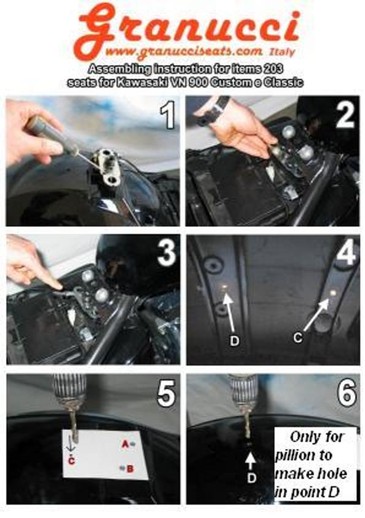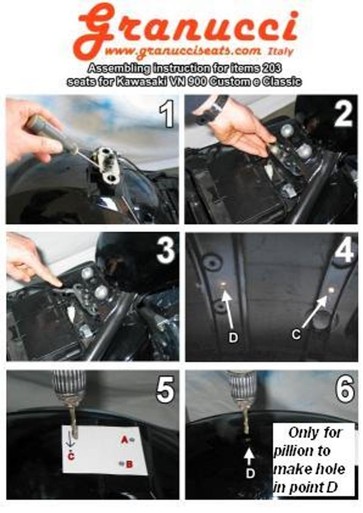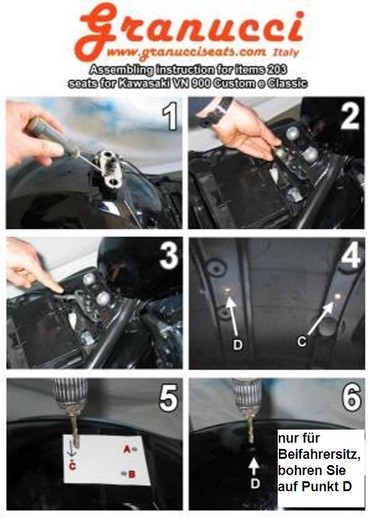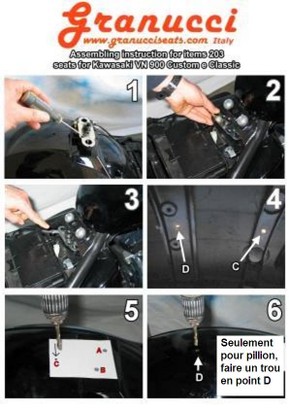asiento Kawasaki VN 900 Custom-VN 900 Classic
INSTRUCCIONES DE MONTAJE
(foto 1) Después que Ustedes han quitado el asiento original, tiene que destornillar los dos tornillos del guardaborros que fijan el bloquito del cierre del asiento original.
(foto 2 y foto 3) El bloquito tiene que ser quitado y puesto entre los tubos del bastidor, bajo el tanque. Ustedes pueden también bloquearlo con una envoltura de teflón.
(foto 4) El guardaborros trasero de VN 900 se apoya de manera transversal a las dos envolturas del bastidor, cada una tiene ya un agjuero central en la parte de metal (C y D) que está cerrado por el guardaborros de plástico.
El asiento largo y el asiento síngulo se montan, poniendo en la parte trasera la abrazadera bajo el tanque (mismo sitio del asiento original) y fijando, en la parte trasera, la abrazadera pequeña que sobresale del asiento con una clavija y un dado que se le suministramos.
Luego, la única cosa que Ustedes deben hacer, antes que monten nuestro asiento, es barrenar el guardaborros cerca del punto C.
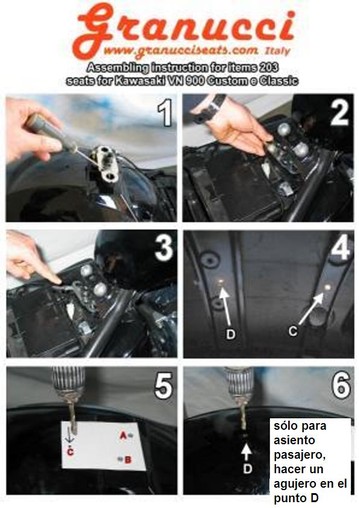
Para ayudarles a identificar el punto C, pueden usar 2 maneras.
Primera manera para identificar el punto C
Cortar la siguiente sagoma de corte:
(foto 5) Ahora tienen que ponerla sobre el guardaborros trasero de manera que los dos puntos A y B coincidan con los agujeros de los 2 tornillos que antes fiajaban el bloque del cierre.
El punto C es el punto de perforación, Ustedes deben usar un trépano con un talandro de diámetro 6 (es mejor utilizar antes un talandro con un tamaño menor).
Segunda manera de identificación del punto C
Para identificar el punto C, en vez que la sagoma, pueden usar un pequeño punzón y abajo (punto C) incidir el guardaborros de plástico sin prisa hasta que este surge a la superficie.
Antes que Ustedes perforen, tienen que estar seguros que el punto es correcto.
(foto 6) Para montar el asientito trasero, que tiene que ser fijado por delante, deben superposicionar su gancho con el gancho del asiento guía y de manera trasera deben bloquear el mismo abajo el guardaborros, en el punto D.
Para hallar el punto D donde Ustedes deben perforar el guardaborros, pueden utilizar también un punzón pequeño e incidir el guardaborros de plástico en el agujero central D de la segunda cinta de metal del bastidor.
|
